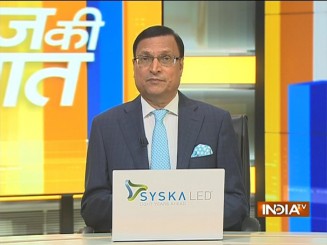 The interim order by the Supreme Court transferring the Gyanvapi case from lower court to district court clearly indicates that the plea of Anjuman Intezamia Masajid Committee seeking stay on all the orders and proceedings of the lower court has not been accepted. The apex court has clearly said that the survey of the complex to ascertain its religious nature is not barred under Places of Worship Act, 1991.
The interim order by the Supreme Court transferring the Gyanvapi case from lower court to district court clearly indicates that the plea of Anjuman Intezamia Masajid Committee seeking stay on all the orders and proceedings of the lower court has not been accepted. The apex court has clearly said that the survey of the complex to ascertain its religious nature is not barred under Places of Worship Act, 1991.
The apex court has said that whether Hindu devotees can be allowed to perform prayers inside Gyanvapi involved complex and sensitive issues that are needed to be dealt with by a seasoned judicial hand, and because of this, the case has now been transferred to the district judge. The Supreme Court has also directed the district court to take up on priority the issue of maintainability of the suit filed by five Hindu female devotees seeking worship of Goddess Shringar Gauri and other deities inside the complex.
The apex court by saying that its May 17 order for providing to security to the Shivling-type structure shall remain, and the district magistrate should make alternate arrangements of ‘wazu’ for Muslim devotees. The ‘wazukhana’ shall remain sealed, but ‘namaaz’ inside the mosque will continue. When the Muslim side sought stay on the survey by court-appointed commissioners, the bench of Justices D y Chandrachud, P S Narasimha and Surya Kant said that there was no bar on checking the religious character of a shrine, and that the Ayodhya and Gyanvapi issues were vastly different.
The apex court order was welcomed by Nagendra Pandey, president of Kashi Vishwanath Temple Trust, who said that the court, whether lower or district court, should verify whether the black stone found was a Shivling or not. If after probe, it was found that it was not a Shivling, Hindus would not press their claim, Pandey said.
On the other hand, AIMIM chief Asaduddin Owaisi said that the apex court order transferring the case from lower to district court, and directing the district court to decide on priority the maintainability of the original suit filed by female Hindu devotees, prove that the arguments placed by the advocate for Muslim side were strong.
Owaisi’s allegation that Muslim devotees in Gyanvapi mosque were facing ablution problems because of sealing of wazukhana, was rejected by the devotees themselves who offered namaaz on Friday. The district administration had provided two huge containers of 1000 litre water along with 50 ‘lotas’ for performing ‘wazu’.
The Shahar Qazi of Benaras Abdul Batin Nomani said on Friday that that it was an old fountain built with old technique, but was lying unused for the last 25 years because people nowadays are not conversant with this technique. Nomani claimed that the Gyanvapi mosque was built many years before Emperor Aurangazeb demolished the Kashi Vishwanath temple. He claimed it was built by Emperor Akbar, based on his secular principle of ‘Deen-e-Ilahi’, and that is why religious Hindu symbols like damru, swastika, can be found on the walls.
Claims and counter-claims aside, the evidences that are now in public domain are known to both the Hindu and Muslim sides. The fact is that Gyanvapi mosque was built after demolishing Kashi Vishwanath temple, the three domes of the mosque were installed atop the spires of the old temple. This has been confirmed in the court commissioner’s report.
The Muslim side knows that if the case proceeds on the basis of temple or mosque, it is bound to lose the case. That is why, none of the Muslim leaders like Owaisi, Shafiqur Rahman Barq or the Shahar Qazi Nomani are rejecting the theory that there existed a temple on the spot where Gyanvapi mosque is located. They are only proferring the Places of Religious Worship Act, 1991 passed during the Congress rule, which clearly says that there shall be status quo as of August 15, 1947, in all religious shrines, except Ayodhya. All shrines will keep their religious characters. Owaisi is saying, ad nauseum, how the Gyanvapi mosque can be declared as part of Kashi Vishwanath temple, as the 1991 Act exists in statute book.
The fact is that the Hindu side is not claiming that it holds ownership rights on the mosque. The Hindu side has only sought permission to offer prayers for Goddess Shringar Gauri, and which has been continuing from August 15, 1947 till 1991. That is why the Supreme Court bench on Friday said that this was not a title suit but a worship suit, and refused to stay the proceedings in lower courts. Owaisi is free to speak his own mind, but his arguments do not hold water, legally.
Some people have been saying that this issue became complex because of the intransigence on part of the Muslim side. Had the Muslim side allowed Hindu plaintiffs to perform pooja of Shringar Gauri, the matter would have ended there, and would not have gone to court, nor would the court have appointed a commissioner to carry out survey and videography. At least the Muslim side would have been spared the process of approaching the Supreme Court. But now, the issue has gone out of hand and will go far. Let the courts decide now.